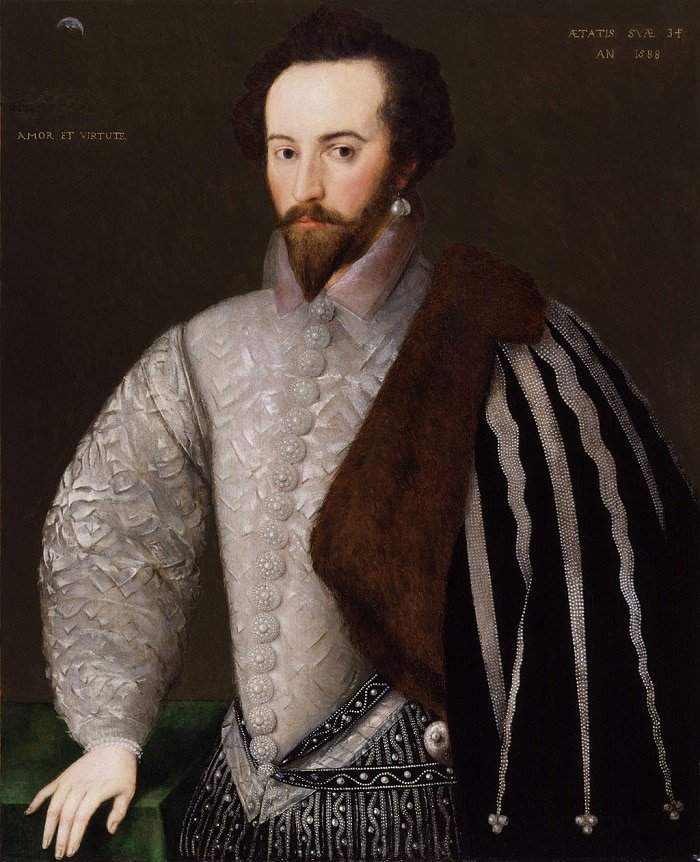Ask most people about Sir Walter Raleigh and they will know him as a soldier, explorer of the New World, and possible lover of Queen Elizabeth I. He introduced tobacco to England, and some say he also introduced the potato to Ireland, although historians dispute the likelihood of this based on where his travels took him. There is, however, one other food-related aspect that often goes overlooked, and that is what we are going to discuss here: Sir Walter Raleigh and his cordials.
Cordials in Elizabethan England
Throughout much of history, food and medicine have been closely related. Today, we may try to follow the mantra “You are what you eat” but in the Elizabethan era, food was medicine. Wealthier households would have books in which they recorded all manner of concoctions designed to be drunk for various ailments. The kitchen was the source of entertainment, perhaps gluttony, nourishment, and healing.
Yet at the same time, the food eaten by the wealthy was becoming a little less healthy, thanks to the introduction of sugar. Elizabeth I had quite a sweet tooth and candies of all sorts featured at her banquets. Perhaps then it is no surprise that the interest in making tonics or cordials rose. As people ate more sugary foods, they may have encountered more health problems, which in turn led them back to the kitchen in search of remedies.
Sir Walter Raleigh

Sir Walter Raleigh was an avid collector of recipes and creator of cordials and herbal remedies. During the reign of James I, he fell out of favour at the royal court and was imprisoned in the Tower of London. Yet his remedies was in high demand. In 1605, the wife of the French ambassador visited him in the Tower to acquire some of his Great Cordial, along with his Balsam of Guiana. The latter was a medicinal strawberry water, later used by Queen Anne.
Life in the Tower wasn’t entirely bad, especially if you were wealthy. Raleigh was allowed to grow many plants which he had brought back with him from his travels to the New World. He used these to continue brewing new medicines. Records show that he also made one of various flowers to help women after giving birth. However, his most famous and no doubt one of his most complex recipes was for his Great Cordial. In fact, several decades later, an apothecary in the Royal Household wrote a lengthy work about it and the beneficial attributes of its ingredients.
Raleigh’s Great Cordial
Raleigh swore by this concoction as an incredible tonic and cure-all. Modern science tells us the opposite. It contains a shocking number of toxic ingredients, including poisonous metals. Nevertheless, it is a fascinating recipe to read.
The Historic Royal Palaces and the University of Reading have worked together to translate the recipe for his Great Cordial which is as follows:
- hart’s horn
- viper flesh, including their hearts and livers
- borage flowers, bugloss flowers, rosemary, marigold, betony, campion, sundew, gilliflower, and elderflower
- germander, holy thistle, lemon balm, Cretan dittony, mint, marjoram, and more betony
- various spices, including: cardamon, juniper berries, mace, saffron, nutmeg, cloves, and a paste made from crushed insects
- cinnamon, sassafras bark, lemon rind, and orange rind
- aloe wood and sassafras wood
- various roots, including: angelica, valerian, snakeroot, snakewort, turmeric, carline, fraxinella, and more.
We’re not done yet with the ingredients. There are more to come! All of the above were made into a tincture and then evaporated into a syrup before being burned, pressed into ash, and made into an elixir by adding to water.
Then he added an array of additional ingredients. These included crushed pearls, crushed coral, several types of clay, more deer horn, ambergris, musk, antimony, and lots of sugar. One can only presume that the final ingredient helped to make it more palatable.
Of course, many of the herbs, fruits, and spices are still widely in use today, both in cooking and as herbal remedies. So adding them to wine to make a tonic is not completely out of the ordinary. But then you have ingredients that were known in the day to carry certain protective powers. Coral, for example, was used in jewellery and baby ornaments to guard their health. Worst of all to us, though, is the antimony – a toxic metal – and the deer horn. While a fascinating recipe from a historical perspective, under no circumstances would we recommend attempting to make or consume this. DON’T DO IT!
Thyme, Lemon and Honey Cordial
If you’d like to try making your own cordial, we suggest this much simpler and safer option. All three main ingredients have beneficial properties and so this might be a welcome warmer when suffering from winter colds.
- 1 tsp dried thyme or a handful of fresh thyme
- 1 slice lemon
- 1 tsp honey
- 1 cup boiling water
Put the thyme into a small teapot and add the boiling water. Allow to steep for 5 to 10 minutes. Strain to remove the thyme leaves. Add lemon and honey to the strained liquid and drink, hot or cold.
If you are interested in learning more about food in the Royal Courts, FutureLearn offers a wonderful free course in conjunction with the University of Reading.



Wow! I never knew this about Walter Raleigh. I don’t think I would have made it past the viper bits. Great post!